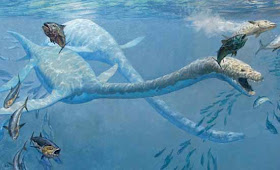
Here's the finish first. There are some caustic effects on the back, with a few fish scattering before those long snaking necks.
I'm showing two hunting in tandem, with a surprise-attack technique of lifting the head up in murky water to grab fish from below. I had to control the values to make the colors get lighter as they go farther back in the water.
Here are two comp sketches, each of which had qualities I liked and didn't like. I liked the pose of the first one, but the water looked too clear. And the second one was a bit too monochromatic, and the fish looked too much like a "bait ball"-- tricky prey, probably too fast for such a big predator.
And here's the first sketch in colored pencils, playing with the idea of turning the page to see the head. When doing illustration sketches for a magazine, I like to see how the picture looks with type around it.
----------
Check out your newsstand for the October issue of Ranger Rick magazine to see the paintings!
Previously on GJ: Caustic Effects, Color Underwater



Got this issue last night. Enjoy showing your posts to my son (6) who is gaining an understanding of how an illustrator works. (What his Dad did before the 2nd child came along. Am getting back into again, though.)
ReplyDeleteHe was cutting your work out of the magazine this morning, as it was the part of the issue he liked best.
There's something very musical about the composition of this painting.
ReplyDeleteThank you for this look at your process. I think that it is easy to see that you combined the best parts of your two sketches.
ReplyDeleteWill your upcoming Color and Light book have information on underwater color?
(Thank you also for this previous post on the subject! http://gurneyjourney.blogspot.com/2010/01/color-underwater.html)
Johnny--yes, "Color and Light" covers the topic, with examples.
ReplyDeleteErik--indeed: Mozart for the Elasmo's, Stravinsky for the fish.
JW--It was my dad who showed me how paintings were different from photos, when I was about the age of your son. I remember how it floored me looking at Z. Burian paintings, which I thought were somehow real.
My daughter LOVES Elasmosaurs. She'll love seeing this.
ReplyDeleteShe also loves Stravinsky, thanks to Little Einsteins.
Thanks James.
Thanks for sharing your process - do you find the color pencils any advantage over oil for studies -- and out curiosity have you ever looked into digital conceptualizing or to you like the mechanical process?
ReplyDeleteAt first I thought the blog post said ELMOsaurus.
ReplyDeleteThanks for showing these! Very convincingly underwater!
Interesting and very cool again.
ReplyDeleteDo you use this technique of "the first sketch in" to figure out the layouts of your books as well? Or is this someone else's job?
The water and light effect is very nice on the creatures' backs. But, I am quite surprised, your colored pencils sketch looks just like a marker rendering.
ReplyDeleteI do enjoy reading about your thought processes on these pieces. I think the most helpful part though is seeing the initial idea in magazine format, with the text surrounding the picture.
ReplyDeleteJames, your blog is an awesome wealth of knowledge for artists of all levels! I love coming here, always something to be gleaned. This a cool post on how to deal with underwater matter.
ReplyDeletecheers